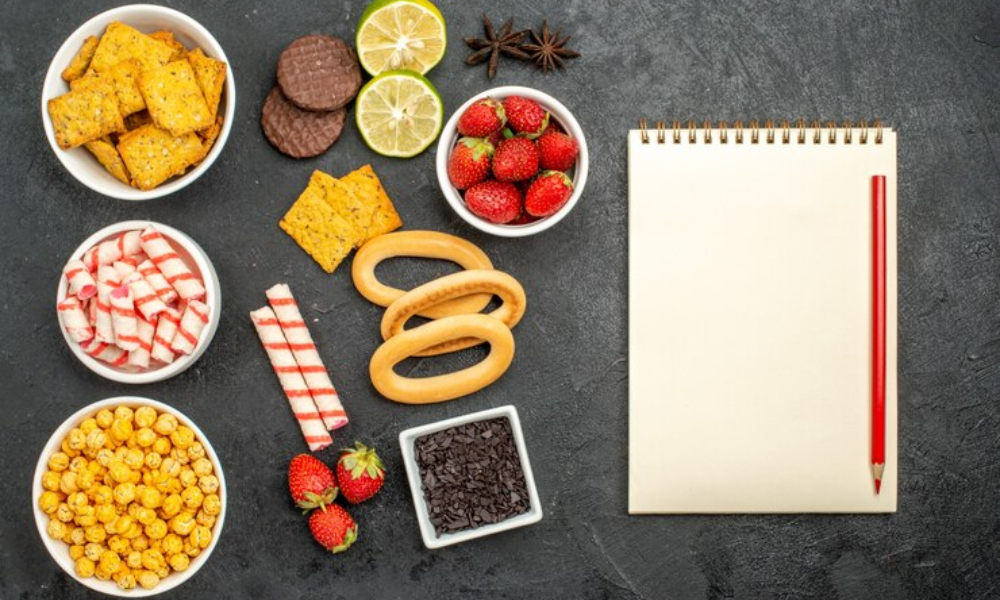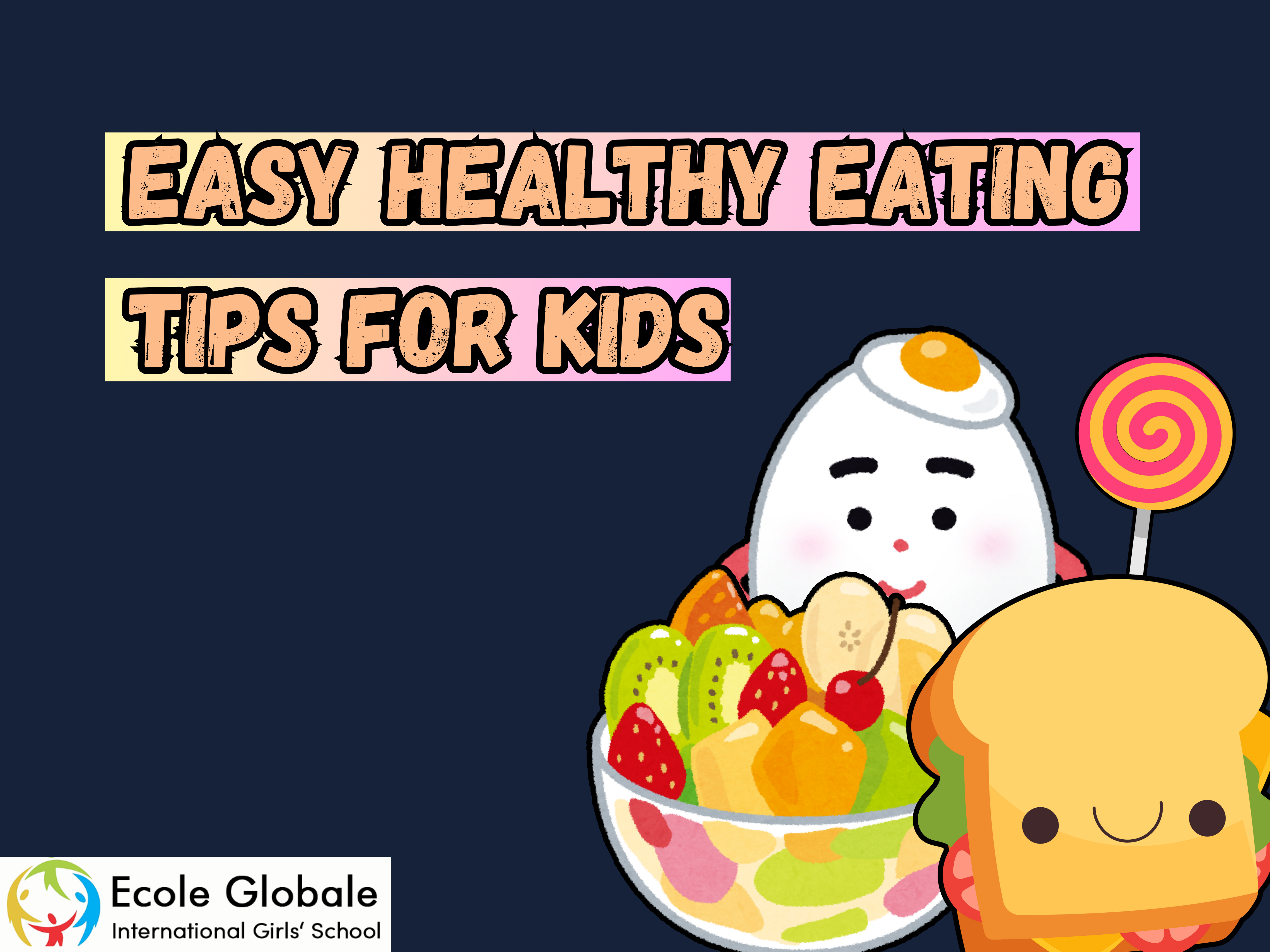Promoting healthy eating habits in children is crucial for their growth, development, and overall well-being. With busy school schedules, peer influences, and an abundance of unhealthy food options, guiding kids toward nutritious choices can be challenging but incredibly rewarding.
A balanced diet helps improve academic performance, boosts energy levels, and strengthens the immune system, equipping students to excel both inside and outside the classroom.
Whether you are a parent looking to improve your child’s diet or a student seeking easy healthy snack ideas, this guide covers it all.
1. Healthy Eating Tips for Students

Encouraging students to eat healthy can significantly impact their concentration, energy levels, and academic performance. Here are some actionable tips to promote the components of healthy eating habits among students:
Create a Balanced Meal Plan
- Include All Food Groups: Incorporate fruits, vegetables, whole grains, proteins, and healthy fats in every meal. This ensures that kids get a variety of nutrients essential for their growth and development.
- Teach Portion Control: Help kids understand the concept of portion sizes to avoid overeating. Use visual cues, like comparing portions to everyday objects (e.g., a serving of protein should be about the size of a deck of cards).
Encourage Regular Meal Times
- Establish Routine: Set regular meal and snack times to help kids develop a routine. This not only helps manage hunger but also regulates their metabolism.
- Importance of Breakfast: Breakfast is the most important meal of the day. Encourage kids not to skip it, as it provides the necessary energy to start their day and enhances focus in school.
Lead by Example
- Model Healthy Eating: Kids often mimic the eating habits of adults. If parents or guardians maintain a healthy diet, kids are more likely to follow suit.
- Family Meals: Make family mealtime a priority. Sharing meals together not only strengthens family bonds but also reinforces healthy eating habits.
Involve Kids in Meal Prep
- Shopping and Cooking: Let kids participate in meal planning, grocery shopping, and cooking. This engagement increases their interest in food and encourages them to make healthier choices.
- Educational Opportunities: Teach them about reading nutrition labels, understanding food groups, and making balanced meals.
Limit Sugary Drinks
- Hydration Over Sugars: Water, milk, or natural fruit juices are healthier alternatives to sugary sodas and energy drinks. Excessive sugar intake can lead to weight gain, tooth decay, and other health issues.
- Infused Water: Make water more appealing by adding slices of fruit, cucumber, or herbs like mint to create a refreshing drink that kids will love.
2. Simple Healthy Food Ideas for Kids

Making healthy food appealing to kids can sometimes be challenging, especially when competing with the allure of fast food and sugary snacks. Here are some simple, kid-friendly food ideas that are nutritious, easy to prepare, and sure to be a hit with kids:
Colorful Veggie Wraps
- Ingredients: Whole-grain wraps, a variety of colorful veggies (bell peppers, cucumbers, carrots), lean proteins (chicken or beans), and a spread of hummus or low-fat cheese.
- Benefits: Packed with fiber, vitamins, and protein, these wraps are fun to eat and can be customized to suit any child’s taste preferences.
Mini Veggie Pizzas
- Ingredients: Whole-grain pita bread, tomato sauce, assorted vegetables, and low-fat mozzarella cheese.
- Preparation: Let kids build their mini pizzas by adding their favorite toppings. Bake until the cheese melts, creating a delicious, healthy meal that feels like a treat.
Smoothie Bowls
- Ingredients: A base of blended fruits (like bananas, strawberries, and spinach) with yogurt, topped with granola, nuts, or seeds.
- Benefits: Smoothie bowls are not only visually appealing but also rich in essential nutrients like fiber, vitamins, and antioxidants.
Veggie-Packed Pasta Salad
- Ingredients: Whole-grain pasta, cherry tomatoes, cucumbers, olives, and a light vinaigrette dressing.
- Customizable: Add protein options like chickpeas or grilled chicken to make it a complete meal.
Homemade Trail Mix
- Ingredients: A mix of nuts, dried fruits, whole-grain cereal, and a few dark chocolate chips.
- Perfect Snack: This trail mix provides a balance of healthy fats, proteins, and carbohydrates, making it an ideal snack for active kids.
3. Quick Healthy Snacks for Students

Healthy snacks play an important role in maintaining students’ energy levels between meals. Here are some quick, easy, and healthy snack ideas that are both nutritious and delicious:
Apple Slices with Peanut Butter
- Nutritional Value: Combines fiber from apples with protein and healthy fats from peanut butter.
- Tip: Opt for natural peanut butter without added sugars or hydrogenated oils for a healthier choice.
Yogurt Parfait
- Ingredients: Low-fat yogurt layered with fresh berries and granola.
- Benefits: A perfect blend of calcium, protein, and antioxidants, making it a satisfying and nutritious snack.
Veggie Sticks with Dip
- Options: Carrot sticks, cucumber slices, and bell pepper strips served with hummus or Greek yogurt dip.
- Healthy Boost: This snack provides essential vitamins and minerals while keeping calorie intake low.
Popcorn
- Why It’s Good: Air-popped popcorn is a whole grain and a good source of fiber, making it a light yet filling snack.
- Healthy Toppings: Season with herbs or a light sprinkle of Parmesan cheese instead of butter and salt.
Cheese and Whole-Grain Crackers
- Combination: Provides protein from cheese and fiber from whole-grain crackers.
- Low-Fat Options: Choose low-fat cheese to keep the snack balanced and nutritious.
4. Healthy Breakfast Ideas for Kids

A healthy breakfast fuels kids for the day ahead, providing the energy and nutrients needed for concentration and learning. Here are some quick and healthy breakfast ideas that are perfect for busy school mornings:
Overnight Oats
- Preparation: Mix rolled oats with milk, yogurt, and your child’s favorite fruits, then refrigerate overnight.
- Toppings: Add nuts, seeds, or a drizzle of honey in the morning for extra flavor and texture.
Scrambled Eggs with Veggies
- Nutritious Start: Scramble eggs with spinach, tomatoes, and a sprinkle of cheese for a protein-rich breakfast.
- Serve With: Pair with whole-grain toast to add fiber and keep kids full longer.
Fruit and Yogurt Smoothie
- Blend: Use a variety of fruits like bananas, berries, and spinach with yogurt for a quick, nutrient-rich breakfast option.
- Add-ons: Boost the smoothie’s nutritional content with chia seeds or flax seeds for additional fiber and omega-3s.
Whole-Grain Pancakes
- Healthier Mixes: Opt for whole-grain or oatmeal-based pancake mixes instead of refined flour.
- Natural Sweeteners: Add blueberries or bananas for natural sweetness and extra vitamins.
Banana and Nut Butter Toast
- Simple and Nutritious: Spread almond or peanut butter on whole-grain toast and top with banana slices for a balanced breakfast that combines healthy fats, protein, and carbohydrates.
5. Tips for Kids to Eat Healthy at School

Eating healthy at school can be a challenge, but with the right strategies, students can maintain their healthy eating habits even in a school environment. Here are some tips to help kids make healthier food choices while at school:
Pack Balanced Lunches
- Lunchbox Essentials: Prepare lunches with a variety of foods, such as whole-grain sandwiches, fruits, and yogurt.
- Bento Boxes: Use bento boxes to separate different food items, making the meal visually appealing and ensuring variety.
Avoid Processed Snacks
- Healthier Choices: Opt for whole foods like fruits, nuts, and cheese sticks instead of processed snacks like chips and cookies.
- Educate Kids: Teach children about the benefits of choosing snacks that provide sustained energy rather than those high in sugars and unhealthy fats.
Encourage Hydration
- Water Bottles: Ensure kids carry a reusable water bottle to school, encouraging regular hydration throughout the day.
- Healthy Alternatives: Substitute sugary drinks with water or milk to avoid the negative impacts of excessive sugar consumption.
Set a Healthy Snack Routine
- Smart Snacks: Pack healthy snacks like fruit, yogurt, or whole-grain crackers for recess to maintain energy levels.
- Avoid Sugary Treats: Limit sugary snacks that can cause energy spikes followed by crashes, affecting concentration and behavior.
Teach Mindful Eating
- Slow Down: Encourage kids to eat slowly and pay attention to their hunger and fullness cues.
- Portion Awareness: Mindful eating helps them recognize when they are full, reducing the tendency to overeat.
Conclusion
Developing healthy eating habits in kids is essential for their physical, mental, and emotional growth. By incorporating balanced meals, involving children in meal planning, and making nutritious foods fun and accessible, parents and students can build a strong foundation for lifelong healthy eating.
Implementing these tips at home and school not only improves kids’ academic performance and energy levels but also sets them up for a healthier future. By taking small, consistent steps, families can create a positive and lasting impact on children’s health and well-being.









